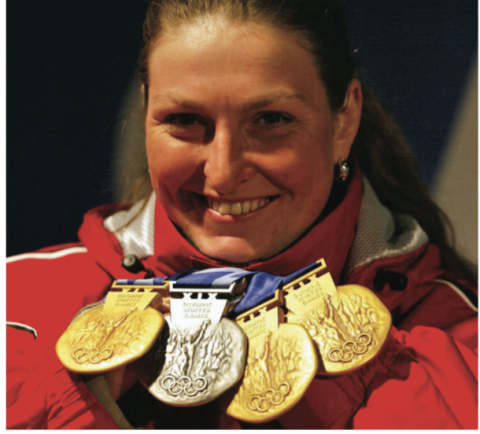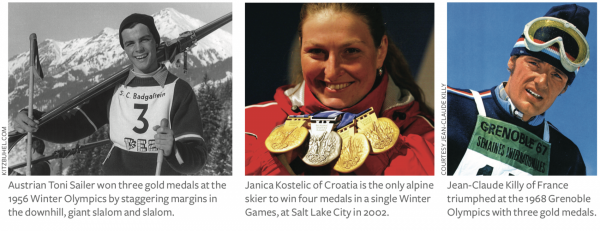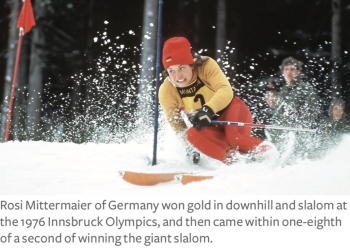
Who’s the greatest? For skiers able to win under pressure, look to their single-Olympics record. By John Fry

Mention the greatest alpine ski racers of all time, and you usually hear a recitation of racers with career-long stats—for example, Sweden’s Ingemar Stenmark, winner over 16 winters of a record 86 World Cup races; and Lindsey Vonn, who has broken Annemarie Moser-Proell’s 62 victories, with 78 by the end of 2017. Neither of them won more than one gold medal in a single Winter Games. And how about Marc Girardelli, with five World Cup titles? And Marcel Hirscher, with a record six? And Karl Schranz, at the top of his game from 1957 to 1972? None of the three is an Olympic gold medalist.
Skiing’s superstars are athletes who don’t appear on lists counting most races won. They won races that most counted. At clutch time, in the Olympics, they showed up.
“The greatest racers win gold at the Olympics and World Championships,” insists 1970 FIS Alpine World Champion Billy Kidd. “The events, compressed into a couple of weeks, demand something that doesn’t come into play in career-long performances and season-long accumulations of points…the ability to win when the chips are down.”
The most outstanding single Winter Olympics alpine skiing performance arguably belongs to Croatia’s Janica Kostelic. At Salt Lake in 2002, she won gold medals in the slalom and giant slalom, won silver in the Super G, and competed in two more races—a downhill and a slalom—to win the combined. She went on to triple-gold at the FIS World Alpine Ski Championships three years later. Not a few experts regard her as the greatest woman ski racer of all time.
Arguably the best male Olympian was 1956 champion Toni Sailer. The margins by which the Austrian superstar won his gold medals were staggering: 3.5 seconds in the downhill, a mind-boggling 6.4 seconds in the one-run giant slalom, and 4 seconds in the slalom. At the 1958 World Championships, Sailer almost repeated his Olympic hat trick, placing first in downhill and giant slalom, and second in the slalom. With jet-black hair and a movie star’s face, the handsome poster boy Sailer went on to act in films and TV mini-series. Later, he served as head coach of the Austrian national team, and chaired the FIS Alpine Committee.
Sailer and Jean-Claude Killy are the only racers to have captured all of the alpine gold medals available to be won in a single Olympics…in their eras, there were just three. (Super G and actively raced combineds didn’t exist at the time.) Killy, 24, was already an internationally acclaimed champion before his 1968 Olympic triumph in the French Alps above Grenoble. The previous winter the Frenchman had won 71 percent of the races on the World Cup calendar, a feat never since repeated. (See “Killy’s Winter, Never Equaled,” Skiing History, January-February and March-April 2017) The pressure on Killy before the Grenoble Games was unimaginably intense. For days on end he was pursued by photographers, autograph seekers and worshipful fans. To escape, Killy went into seclusion a week before the lighting of the Olympic flame. When he showed up in the starting gate, he was psyched and ready. He pulled off the gold medal hat trick, albeit winning by narrower margins than Sailer had.
In an almost superhuman performance at the 2002 Salt Lake Winter Olympics, Norway’s Kjetil Andre Aamodt competed in all five alpine events, gold-medaling in the Super G and the combined, placing 4th in the downhill, 6th in the slalom, and 7th in GS. Remarkably, in four separate Winter Games, Aamodt won an unrivaled total of seven Olympic alpine medals.
Bavaria’s Rosi Mittermaier in 1976, and Liechenstein’s Hanni Wenzel in 1980, both narrowly missed performing the Sailer-Killy hat tricks. At the Innsbruck ’76 Olympics, after gold-medaling in the downhill and slalom, Mittermaier came within one-eighth of a second of winning the giant slalom. As a result she won the paper combined title, not an Olympic medal. Married to former German champion Christian Neureuther, Mittermaier is the mother of World Cup racer Felix Neureuther.
At the Lake Placid 1980 Winter Olympics, Liechenstein’s Hanni Wenzel won gold medals in the slalom and giant slalom, narrowly missing the hat trick with a silver in the downhill on Whiteface Mountain. She easily won the World Championship gold medal in the combined, its final appearance on paper as a statistical combination of slalom and downhill. That winter she won the 1980 overall World Cup season title as did her brother Andy, a family triumph. Hanni was banned from the 1984 Winter Olympics by the International Ski Federation (FIS) for accepting promotional payments directly, rather than through her national ski federation, removing her chance of winning another Olympic medal. Sweden’s Ingemar Stenmark was similarly affected. Like Wenzel, he was a double gold medalist at Lake Placid. The only other Olympic medal Stenmark ever won was a bronze at Innsbruck in 1976. His record total of 86 World Cup wins has yet to be surpassed.
In 1952 at Oslo, fiercely determined Andrea Mead Lawrence won two Olympic gold medals at the age of only 19, an unprecedented youthful achievement. She crashed in the downhill trying to win a third gold. She’s the only American to win twice in a single Olympics, a record that Mikaela Shiffrin may break in Korea.
 For an Olympic performance under pressure it’s hard to equal what Austria’s Hermann “the Herminator” Maier did at the 1998 Winter Olympics in Japan. After a spectacular airborne, body-crunching crash in the downhill, he rose like a man from the dead, and went on to win both the Super G and the giant slalom gold medals. Following a nearly fatal motorcycle crash in 2001 that left him with a mangled leg, Maier rose to become overall World Cup champion again.
For an Olympic performance under pressure it’s hard to equal what Austria’s Hermann “the Herminator” Maier did at the 1998 Winter Olympics in Japan. After a spectacular airborne, body-crunching crash in the downhill, he rose like a man from the dead, and went on to win both the Super G and the giant slalom gold medals. Following a nearly fatal motorcycle crash in 2001 that left him with a mangled leg, Maier rose to become overall World Cup champion again.
Switzerland’s Vreni Schneider was a 1988 double gold medalist in slalom and giant slalom at Calgary. Additionally, she won another three Olympic medals, including a gold, at Lillehammer in 1994, plus six FIS World Championship medals. She is one of the great women ski racers of all time, winning 55 World Cup races, a total exceeded only by Lindsey Vonn and Annemarie Moser Proell.
Arguably the most electric personality who ever appeared in the starting gate of a ski race, Alberto Tomba was a double gold medalist at the 1988 Calgary Winter Olympics. Over a dozen winters from 1986 to 1998, Tomba won 13 world championship and Olympic medals, plus no fewer than 50 World Cup slaloms and giant slaloms. Powerfully built, with curly black hair and a volcanically engaging Italian charisma, La Bomba at Calgary famously presented ice skater Katarina Witt with a huge bouquet of flowers as she glided off the ice from her gold-medal-winning performance.
Olympic medals can’t deliberately be won, once observed Bode Miller, who’s on camera as a technical analyst for NBC in Korea. “In ski racing,” he said, “you have on-days and off-days, and sometimes the Olympics fall on an off-day. It’s the law of averages.”
Maybe, but the great Olympic champions weren’t racers who succumbed to the inevitability of averages. They went out and conquered off-days and the law of averages by winning multiple medals. I bow in reverence to the golden men and women of our sport.
John Fry covered the ski races at four Olympic Winter Games. “How Skiing Changed the Olympics” is the subject of a chapter in his award-winning book The Story of Modern Skiing, published in 2006.
